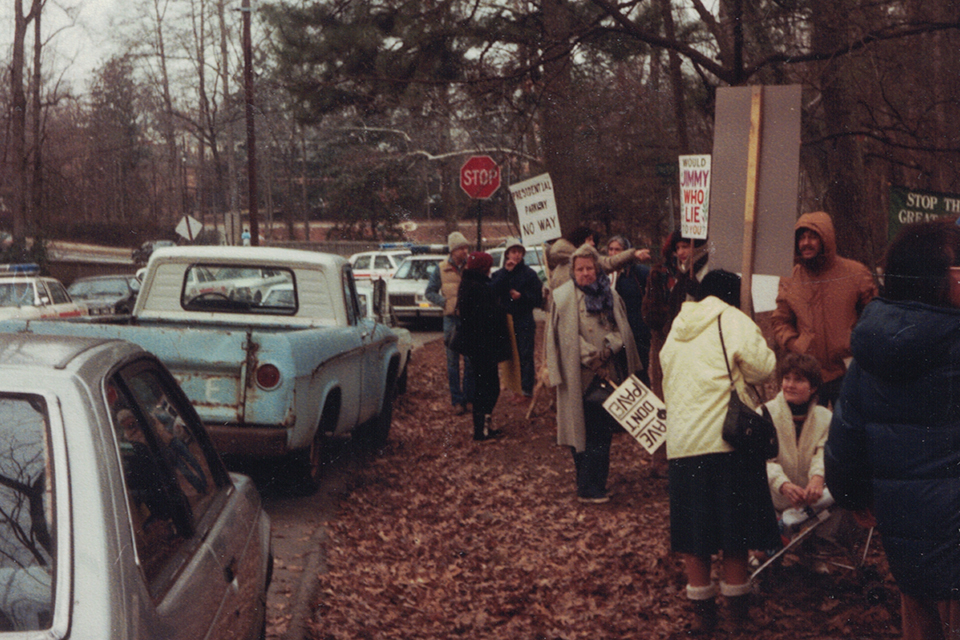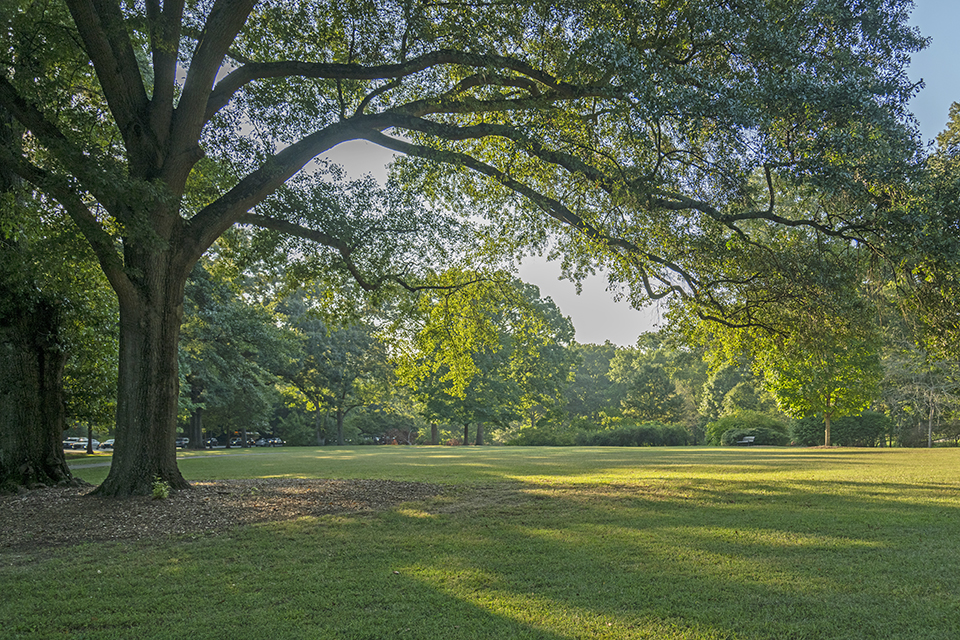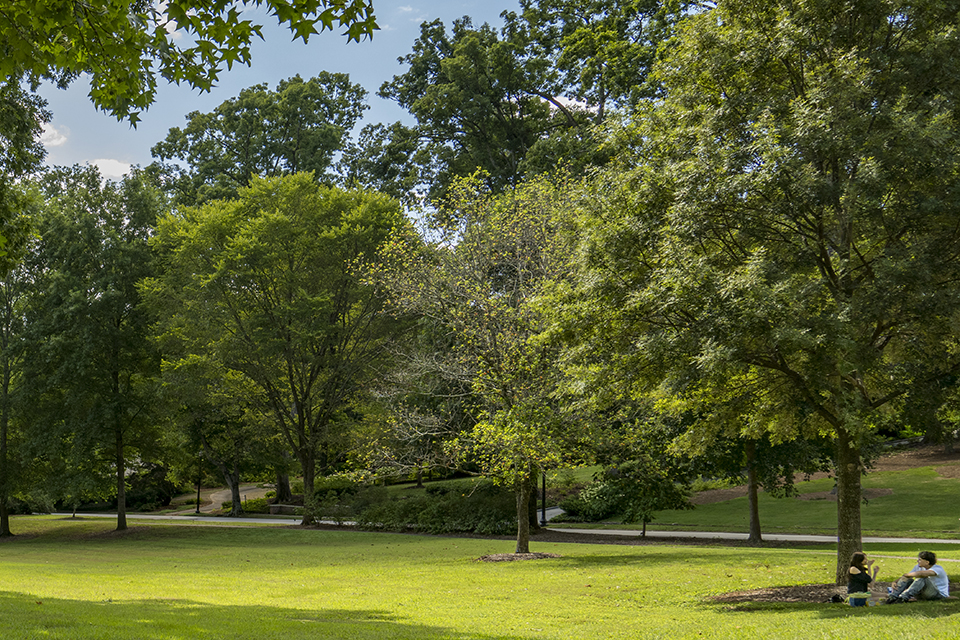The last residential community designed by Frederick Law Olmsted, Sr., and the only subdivision in which all three Olmsteds were involved, Druid Hills’ spinal column is the curvilinear Ponce de Leon Avenue and its necklace of six parks. In the 1980s the expansion of Ponce de Leon into an expressway and a connection to the proposed parkway for the Jimmy Carter Presidential Library and Museum would have significantly altered three of the linear parks and forever decimated the Picturesque character of the neighborhood. Residents protested and finally won a consent decree that preserved and protected the neighborhood in 1991.
History
In the late nineteenth century, Atlanta developer Joel Hurt engaged Fredrick Law Olmsted, Sr., to design a residential community. Olmsted, Sr., worked with John Charles Olmsted, revealing two plans in 1893. In the second plan, “Ponce de Leon Parkway,” a divided, curvilinear avenue following existing topography, serves as the community’s central spine. The proposed parkway was interlaced with six linked public parks, reimagining the traditional village green into a linear, two-mile-long scenographic experience. The Panic of 1893 delayed the project and in 1905 Olmsted Brothers updated the plan, retaining the parkway (now Ponce de Leon Avenue) and its six public parks.
 General Plan for Druid Hills with Shadyside and Dellwood Parks highlighted, 1905. Courtesy of the National Park Service, Frederick Law Olmsted National Historic Site.
General Plan for Druid Hills with Shadyside and Dellwood Parks highlighted, 1905. Courtesy of the National Park Service, Frederick Law Olmsted National Historic Site.
In the postwar era in Atlanta and nationally, sacrificing parkland (and neighborhoods) for highway construction was widely embraced. Eventually there was blowback. In 1975, prompted in part by a proposed freeway project, the Druid Hills Civic Association nominated the “Druid Hills Parks and Parkways” to the National Register of Historic Places. In 1979 the more expansive 1,300-acre Druid Hills Historic District was listed in the National Register. Two years later plans to construct the freeway reemerged to provide access to the Carter Library. The result would have substantially widened Ponce de Leon and introduced freeway on- and off-ramps on the western edges of Shadyside and Dellwood Parks.
The proposals concerned Druid Hill resident Sally Harbaugh who joined the newly-formed National Association for Olmsted Parks (NAOP), a national network of Olmsted park and landscape stewards and advocates. Through NAOP, she learned about Buffalo, N.Y.’s Kensington Expressway, which was constructed over the Humboldt Parkway and routed through Delaware Park (both designed by Olmsted, Sr.) in the 1960s. Harbaugh leveraged this knowledge to recruit others.
Harbaugh galvanized many of her neighbors, who, like her, were unaccustomed to activism. Their involvement in three advocacy groups – Roadbusters, the Olmsted Park Society (OPS), and a coalition of nine neighborhood associations named CAUTION (Citizens Against Unnecessary Thoroughfares in Older Neighborhoods) – bolstered collaborative challenges to road construction. Strategically located protests took place at the site of the proposed Carter Library (completed in 1986), city hall, the state capital, and in the Druid Hills neighborhood parks of Shadyside and Dellwood.
 Rally in Dellwood Park, 1984, Photo Courtesy Jennifer J. Richardson.
Rally in Dellwood Park, 1984, Photo Courtesy Jennifer J. Richardson.
At the onset of construction protestors vandalized machinery, removed survey stakes, and perched atop cranes. Others climbed and occupied trees marked for removal or chained themselves to tree trunks. Images of the women being arrested and dragged from trees by police generated front-page coverage in local newspapers, raising public awareness of the demonstrations. Many participants had never publicly protested before and believed that doing so was the best way to advance their cause. Protestors transformed Shadyside Park into a “tent city” and slept under trees to prevent their removal. At the adjacent Dellwood Park, lawn expanse served as stages for rallies where speakers, including then-city council member John Lewis, rallied against the proposed freeway.
 “Tent City” in Shadyside Park, No Date. Photo Courtesy Jennifer J. Richardson.
“Tent City” in Shadyside Park, No Date. Photo Courtesy Jennifer J. Richardson.
The Druid Hills protestors successfully advocated for the intrinsic value of public parks and historically significant landscape designs, giving weight to the movement to revitalize Olmsted-designed parks taking hold across the city. Two miles west of the neighborhood, 219 acres of homes, businesses, and a part of Goldsboro Park had been leveled and graded in preparation for construction. While this was not an Olmsted design, the coalition formed by Roadbusters, OPS, and CAUTION organized to stop the expressway long before it even reached the historic neighborhood. Lawsuits filed by CAUTION argued the city had unlawfully secured land for construction by condemning public parks, demonstrating a pattern of behavior by state and city officials who supported expressways over access to public space. Protestors experienced alternating victories and defeats, with construction resuming after every loss.
In 1991, Druid Hill residents finally won protection for their neighborhood. The cleared land west of the neighborhood became Freedom Park, the city’s largest park at that time, and a smaller parkway was proposed in place of the expressway. Today the tree-lined John Lewis Freedom Parkway, named for the seventeen-term congressman, has only two lanes, a 35-mph speed limit, and terminates at Ponce de Leon Avenue, just .6 miles west of Olmsted’s Druid Hills. The advocacy and collaboration manifested by the protests solidified community commitment to the preservation of the parks, culminating in the establishment of the Olmsted Linear Park Alliance (OLPA) in 1997 whose mission is to “preserve and protect” the Olmsted design legacy.

Interpretive Sign in Shadyside Park with “Tent City” Photograph. Photo by Robert Semsch, 2024.
Visibility
Thanks to advocates like Sally Harbaugh, an early member of the National Association for Olmsted Parks which was founded in 1980, Atlanta was a pioneering model for the preservation, protection, and renewal of Olmsted’s historic parks and landscapes. The efforts to list Druid Hills Parks and Parkways (1975) and the entire Historic District (1979) in the National Register of Historic Places were among the earliest efforts to recognize and protect Olmsted’s design legacy.
Today Druid Hills looks much as it did when the protests took place, as the efforts of OLPA have restored and rehabilitated its parks and parkways. Although visible signals of the twelve mature canopy trees that were felled by construction crews in 1985 are long gone and are fading from public memory, those that were protected stand as witnesses to the protests. A handful of reminders of those earlier events can be found throughout the neighborhood: an interpretive sign in Shadyside Park notes the protests and features a photograph of the “tent city” that was erected there; and a bench dedicated to a community member is labeled, “Park Lover, Expressway Fighter.” In Freedom Park, approximately two miles west of Druid Hills, is another interpretive sign.
Supplementary online interpretive materials about the protests are limited. The Druid Hills Civic Association, one of the most influential neighborhood groups within CAUTION, states in its mission that their work “involves exercising vigilance in land use and zoning matters,” but does not elaborate on its involvement in the 1980s protests or legal battles. Although OLPA describes its origins beginning with the work done in 1995 by stakeholders after the consent decree was issued, it also includes a link to a PBS documentary clip that shows footage from the 1985 protests as well as portions from an interview with Sally Harbaugh.
While Roadbusters and CAUTION dissolved after successfully stopping the road project in 1991 several participating neighborhood associations, including the Druid Hills Civic Association and the Inman Park Neighborhood Association, are still active. The latter details the protests on their website and hosts a YouTube channel that features footage from the events. In 2020 the organization collaborated with the Atlanta History Center, producing nine oral histories, including one featuring the late congressman, John Lewis.
What You Can Do to Help
Contact Sandra Stewart Kruger, Executive Director of Olmsted Linear Park Alliance, to recommend increasing the visibility of the protests through commemorative events, onsite and online interpretation; updating the National Register of Historic Places nomination to expand the period of significance to include the protests; and applying for the Druid Hills Historic District to be listed as a National Historic Landmark.
Sandra Stewart Kruger, Executive Director
Olmsted Linear Park Alliance
P.O. Box 5500, Atlanta, Georgia 31107
T: (404) 377-5361
E: AtlantaOlmstedPark@gmail.com
Although its origins may fade from memory, the consent decree that saved the parkway continues to offer protection from new construction projects. Two years ago, threats posed to Druid Hill’s Deepdene Park by the Georgia Department of Transportation prompted TCLF to include it in that year’s Landslide report and digital exhibition, The Olmsted Design Legacy. Threats to Olmsted’s parks and parkways are ever present and require constant vigilance, public education, and engagement.

-
Photo by Robert Semsch, 2024.









